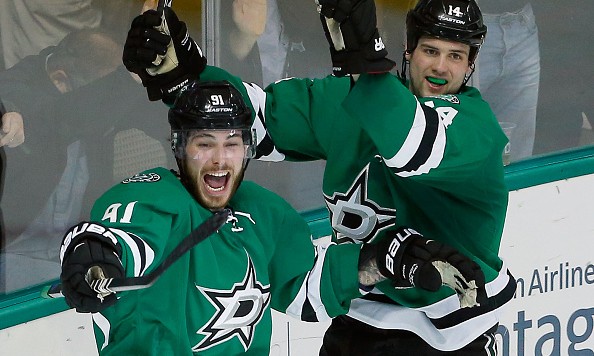Through 30 games played, the Dallas Stars have more points than anyone in the NHL. They have an eight-point lead over both Chicago and St. Louis in the crazy good Central Division despite having played one game fewer than both.
This doesn’t feel like all that much of a surprise despite the fact that Dallas finished sixth in the Central and out of the playoffs last season. Maybe it’s because last season was supposed to be so much more. The Stars were coming off a 91-point season and their first playoff berth in six years. They actually eclipsed that point total, finishing with 92, but didn’t make the type of jump they were expected to. After a solid showing against Anaheim in the first round of the 2014 playoffs, the Stars added Jason Spezza in free agency. That, combined with Spezza and Benn’s continued growth, figured to be enough to push Dallas further into the postseason in 2014-15.
A disastrous season in net and some bad luck ensured no such improvement would happen during the 2014-15 season. The normally-solid Kari Lehtonen had a horrific .903 save percentage in 65 games. Backups Jhonas Enroth and Anders Lindback didn’t fare any better, sporting save percentages of .906 and .875, respectively.
GM Jim Nill helped the situation in net somewhat over the summer, signing Antti Niemi to a multi-year deal. Niemi and Lehtonen have split time so far, posting save percentages of .909 and .911. This is an improvement over last season, but still well below league average. But considering the Stars are on pace for a 34-point jump (they’ll probably slow down at some point, but still), improvements have definitely come in other areas.
Last year, the Stars were second in the league with 261 goals, but 26th with 260 allowed. This year, they’re on pace to finish with 279 scored and 191 allowed. While the goaltending hasn’t improved much, the team is allowing 1.3 fewer shots per game. Their possession numbers have improved in all situations. In fact, they’re now one of the best teams in the league in basically every situation. The power play has jumped from eighth to fourth-best in the NHL while the penalty kill has mostly stayed the same.
Johnny Oduya and Patrick Sharp have both been solid additions. Defenseman John Klingberg is averaging a point per game. Seguin and Benn have continued to improve, now tied for second in the league with 40 points each. Spezza has continued to produce as well.
This team is unlike any other in the NHL from an offensive standpoint. The Seguin/Benn duo is an absolute nightmare to have to defend. The combination of speed, size, hands and hockey IQ make both players mostly unstoppable. Throw in puck-mover extraordinaire Klingberg, Spezza, Sharp and a solid group of role players and the Stars are the most dangerous offensive team in hockey.
But we knew that coming into the season. We knew before last season that they’d be able to score. What’s changed is the conversation surrounding the team. Last year, the Stars were mostly talked about as an exciting team to watch, but not necessarily a model to copy. They were more fun to watch than they were respected as a contender.
This year, with their massive improvements in the standings and hockey’s continued scoring problem, the conversation has shifted. The Stars epitomize the direction in which fans would like hockey to move. More scoring, more speed, more space, less of an emphasis on defense. Fans want to see more goals. Fans want to see the best offensive players have space to work. What fans want doesn’t usually matter to GMs and coaches. But if this iteration of the Stars brings home a Cup at some point – they may begin to take notice. It seems like plenty of fans understand this. The Stars will have a bandwagon brimming with concerned hockey fans come spring.
This is the biggest shift since last season. The Stars have gone from a high-scoring, yet mediocre team to the possible model of how to drag hockey out of the dark ages.
Not bad for a one-year turnaround.

